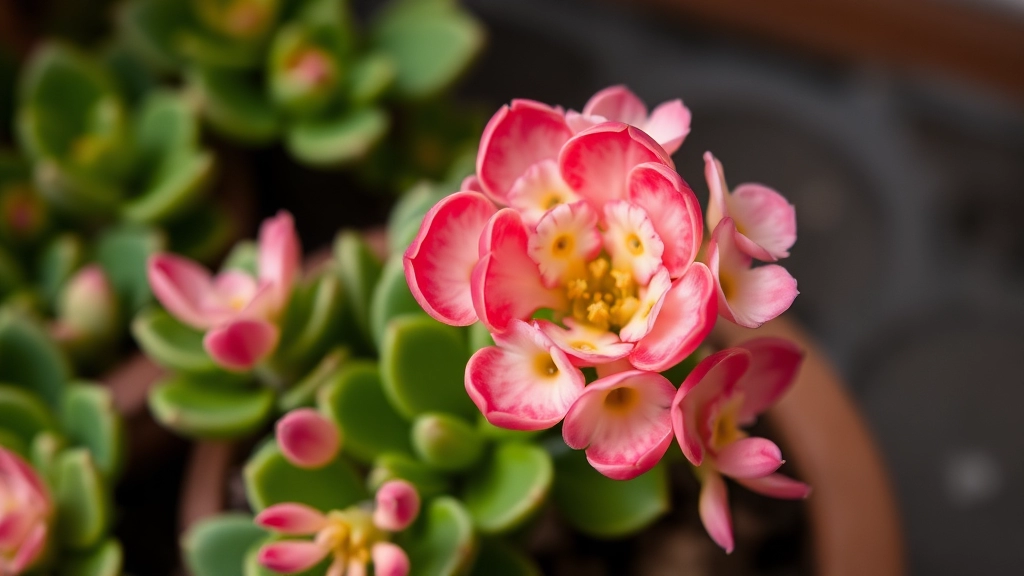Welcome to the vibrant world of Kalanchoe blossfeldiana
A succulent that’s as tough as it is beautiful! This Madagascar native has taken homes worldwide by storm, and it’s not hard to see why. With its glossy leaves and rainbow of flower colors, this low-maintenance marvel is perfect for both novice gardeners and green thumbs alike.
In this comprehensive guide, we’ll dive into everything you need to know about Kalanchoe blossfeldiana. From ideal growing conditions and watering tips to propagation methods and troubleshooting common issues, we’ve got you covered. Whether you’re looking to add a pop of color to your space or seeking a resilient plant companion, this “Flaming Katy” is sure to impress. Let’s explore the captivating world of Kalanchoe blossfeldiana together!
Overview of Kalanchoe Blossfeldiana
Ever stumbled upon a plant that’s both tough and pretty? Meet Kalanchoe Blossfeldiana.
This little beauty’s got a lot going for it.
Native to Madagascar, it’s a succulent that’s made its way into homes worldwide.
Why? It’s easy to care for and blooms like crazy.
What’s the deal with Kalanchoe Blossfeldiana?
It’s part of the Crassulaceae family – fancy talk for succulents.
These plants are champs at storing water in their leaves.
That’s why they’re so low-maintenance.
The look
Kalanchoe Blossfeldiana’s got thick, glossy leaves.
But the real showstoppers are its flowers.
They come in a rainbow of colours – red, pink, orange, yellow, you name it.
Why people love it
- It’s perfect for beginners
- Flowers last for weeks
- Doesn’t need much water
- Thrives indoors
Fun fact
In some places, they call it “Flaming Katy” or “Christmas Kalanchoe”.
Kalanchoe Blossfeldiana is a plant that keeps on giving, with minimal fuss.
Ideal Growing Conditions
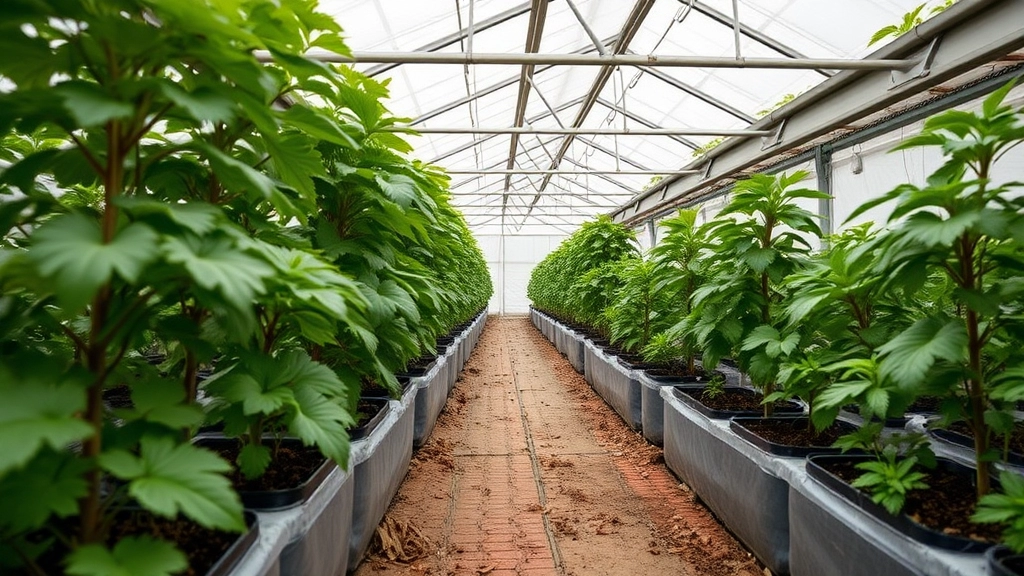
Alright, let’s chat about the perfect setup for your Kalanchoe Blossfeldiana. Trust me, I’ve been there – trying to figure out how to keep these beauties thriving. It’s not rocket science, but there are a few key things you’ll want to nail.
First up, location, location, location:
- Bright, indirect light is your best bet
- A spot near a window, but not in direct sunlight
- Avoid drafty areas or places with sudden temperature changes
Now, let’s talk temperature:
- These guys like it warm, around 15-21°C (60-70°F)
- They can handle a bit cooler at night, but not below 10°C (50°F)
- If you’re comfy, your Kalanchoe probably is too
Humidity’s not a big deal for these tough cookies:
- They’re cool with average room humidity
- No need to mist or use a humidifier
- If your skin’s not feeling dry, your plant’s probably fine
Here’s a pro tip: rotate your Kalanchoe every few weeks. It’ll grow more evenly and you’ll avoid that awkward lean towards the light. Trust me, I learned this the hard way!
Remember, these plants are pretty forgiving. They’re not divas demanding perfect conditions 24/7. But get these basics right, and you’ll have a happy, healthy Kalanchoe Blossfeldiana showing off its gorgeous blooms.
So, what’s the bottom line on ideal growing conditions for Kalanchoe Blossfeldiana? Keep it bright, keep it warm, and don’t overthink the humidity. Easy peasy, right?
Watering Requirements
Alright, let’s dive into the watering requirements for Kalanchoe Blossfeldiana.
Here’s the deal with these succulents:
They’re not big drinkers, folks.
Overwatering? That’s their kryptonite.
So, how do we keep ’em happy without drowning ’em?
Let’s break it down:
Watering Frequency:
- Less is more
- Wait for the soil to dry out between waterings
- In summer, maybe once a week
- Winter? Even less – every 2-3 weeks might do
How to Water:
- Drench the soil thoroughly
- Let excess water drain out
- No standing water in the saucer, please!
Signs You’re Overwatering:
- Yellowing leaves
- Soft, mushy stems
- Fungus gnats partying in the soil
Signs You’re Underwatering:
- Droopy leaves
- Crispy, brown leaf edges
- Slow growth
Pro Tip: Stick your finger in the soil. If it’s dry 2 inches deep, it’s watering time.
Remember, these plants are survivors. They’d rather be a bit thirsty than swimming.
Got questions about watering your Kalanchoe? Hit me up in the comments.
Next time, we’ll chat about the dirt they love. Stay tuned!
Soil and Fertilization
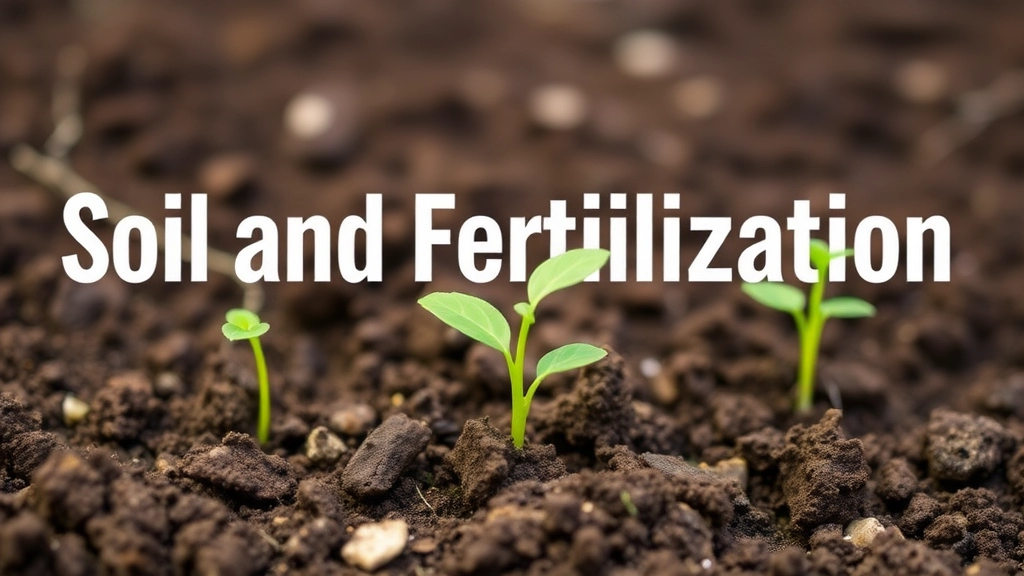
Alright, let’s chat about getting the dirt right for your Kalanchoe Blossfeldiana. Trust me, this little beauty isn’t too fussy, but give it what it wants, and it’ll reward you big time.
The Dirt on Soil
First things first, these succulents need soil that drains faster than your bank account on payday. Here’s the deal:
- Go for a mix that’s about 50% potting soil and 50% perlite or sand
- Think cactus or succulent mix if you’re feeling lazy (I won’t judge)
- Avoid heavy, water-retaining soils like the plague
Why? Because Kalanchoe roots hate sitting in water. They’ll rot faster than a forgotten avocado in your fridge.
Feeding Time
Now, about fertilizer. These guys aren’t gluttons, but they do appreciate a good meal now and then. Here’s the lowdown:
- Feed during the growing season (spring and summer)
- Use a balanced, water-soluble fertilizer (something like 10-10-10)
- Dilute it to half strength – we’re not trying to create a Kalanchoe on steroids
- Feed every 2-4 weeks
Pro tip: Ease up on the fertilizer when your Kalanchoe’s flowering. Too much of a good thing can make the blooms drop faster than your motivation on a Monday morning.
pH Matters (But Not Too Much)
Kalanchoe Blossfeldiana likes its soil slightly acidic to neutral. We’re talking a pH of 6.0 to 7.5. But don’t stress if you’re not hitting it exactly – these plants aren’t divas about it.
The Repotting Game
Eventually, your Kalanchoe might outgrow its pot. When that happens:
- Choose a pot just one size up
- Make sure it has drainage holes (seriously, don’t skip this)
- Repot in spring, right after flowering
Remember, Kalanchoe Blossfeldiana actually likes being a bit root-bound. It’s like they enjoy a snug hug from their pot.
Bottom line? Keep the soil loose, the drainage good, and the feeding light. Do that, and your Kalanchoe will be living its best life, showing off those gorgeous blooms like it’s no big deal. Now, who’s ready to get their hands dirty?
Light and Temperature Needs
Alright, let’s chat about Kalanchoe Blossfeldiana’s light and temp preferences.
These succulents are sun-lovers, no doubt about it.
But here’s the thing – they’re not fans of scorching direct sunlight.
Think bright, indirect light. That’s their sweet spot.
Got a south-facing window? Perfect. Just pop a sheer curtain up.
Now, temperature-wise, these guys are pretty chill (pun intended).
They’re cool with normal room temps, around 60-75°F (15-24°C).
But here’s a pro tip: they bloom better with cooler nights.
Drop the temp to about 50-55°F (10-13°C) at night during fall and winter.
It’ll trigger those gorgeous blooms.
Just don’t let ’em freeze, yeah? They’re not frost-hardy.
In summer, they can handle a bit more heat.
But anything over 80°F (27°C) might stress them out.
Remember, these plants are adaptable.
They’ll tolerate lower light, but you’ll see less growth and fewer flowers.
So, what if your Kalanchoe’s looking a bit sad?
Leggy stems? Pale leaves? It’s probably crying out for more light.
On the flip side, crispy brown edges might mean too much direct sun.
Just move it around until you find that Goldilocks spot.
It’s all about balance with Kalanchoe Blossfeldiana’s light and temp needs.
Common Pests and Diseases
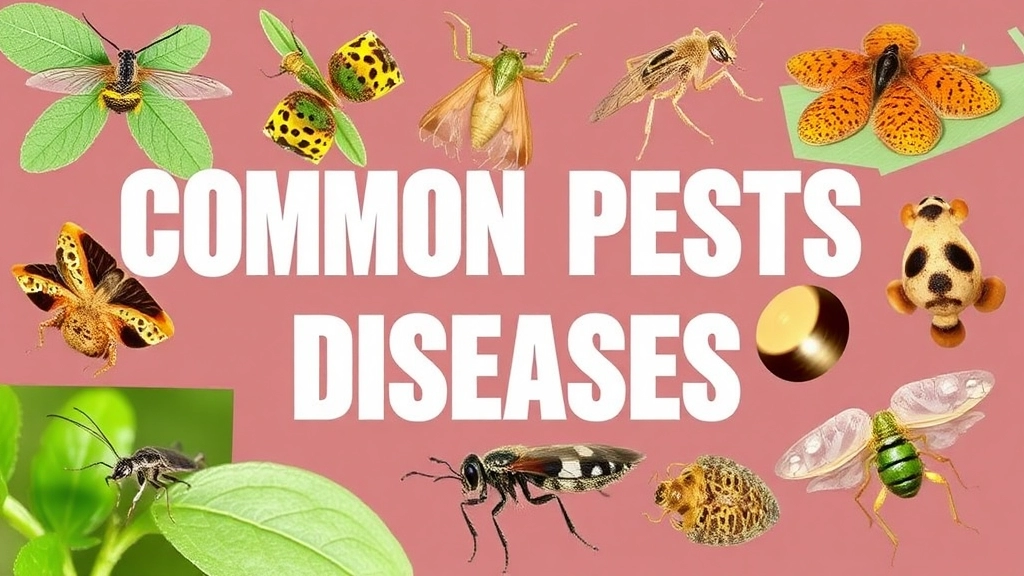
Listen up, plant lovers! Let’s chat about the nasty critters and pesky problems that can mess with your Kalanchoe Blossfeldiana. Trust me, I’ve been there, and it’s not fun. But don’t sweat it – I’ve got your back with some real-talk solutions.
Creepy Crawlies to Watch Out For
- Mealybugs: These little cotton-ball lookalikes are a right pain. They suck the life out of your plant, literally.
- Spider mites: Tiny but terrible, these guys leave webs and cause leaf damage.
- Aphids: Small, soft-bodied insects that cluster on new growth and suck sap.
Plant Diseases That’ll Make You Go “Ugh”
- Root rot: This is what happens when you love your plant a bit too much with water.
- Powdery mildew: Looks like someone sprinkled flour on your leaves. Not cool.
- Leaf spot: Brown or black spots on leaves that can spread if not dealt with.
How to Keep Your Kalanchoe Fighting Fit
- Regular check-ups: Give your plant a once-over every week. Catch problems early, and you’re halfway to solving them.
- Clean and quarantine: If you spot trouble, isolate that plant faster than you can say “Kalanchoe Blossfeldiana”. Clean tools between plants to avoid spreading issues.
- Natural remedies: Before reaching for the big guns (chemical pesticides), try some home remedies:
- Neem oil spray for most pests
- Rubbing alcohol on a cotton swab for mealybugs
- A strong blast of water for aphids (they’re not the best climbers)
- Improve air circulation: Crowded plants are unhappy plants. Give them some breathing room.
- Proper watering: Remember, overwatering is like sending out an invite to fungi and bacteria. Let the soil dry out between waterings.
Pro Tip: Prevention is better than cure. Keep your Kalanchoe stress-free with the right light, water, and nutrients, and it’ll be better equipped to fight off invaders.
Look, dealing with pests and diseases isn’t anyone’s idea of a good time. But catch ’em early, act fast, and your Kalanchoe Blossfeldiana will be back to its blooming best in no time. Stay vigilant, plant pals!
Propagation Methods
Let’s talk about growing more Kalanchoe Blossfeldiana, shall we?
It’s actually pretty simple to multiply these beauties.
Here’s the deal:
Leaf Cuttings:
- Snip a healthy leaf
- Let it dry for a day or two
- Stick it in some well-draining soil
- Keep it moist, not soggy
- Watch for tiny plants to sprout
Stem Cuttings:
- Cut a 4-inch stem below a leaf node
- Remove lower leaves
- Dip in rooting hormone (optional, but helps)
- Plant in a pot with good drainage
- Keep soil slightly damp
Division:
- Gently remove the plant from its pot
- Separate the root ball into smaller sections
- Replant each section in its own pot
Seeds:
- Collect seeds from spent flowers
- Sow on top of moist soil
- Cover with a thin layer of soil
- Keep warm and moist until germination
Pro tip: Spring or early summer is the best time for propagation.
Remember, patience is key. These little guys take time to grow.
Got any Kalanchoe cuttings lying around? Why not give it a go?
Propagating Kalanchoe Blossfeldiana is a fun way to expand your plant family without breaking the bank.
Seasonal Care Tips for Kalanchoe Blossfeldiana
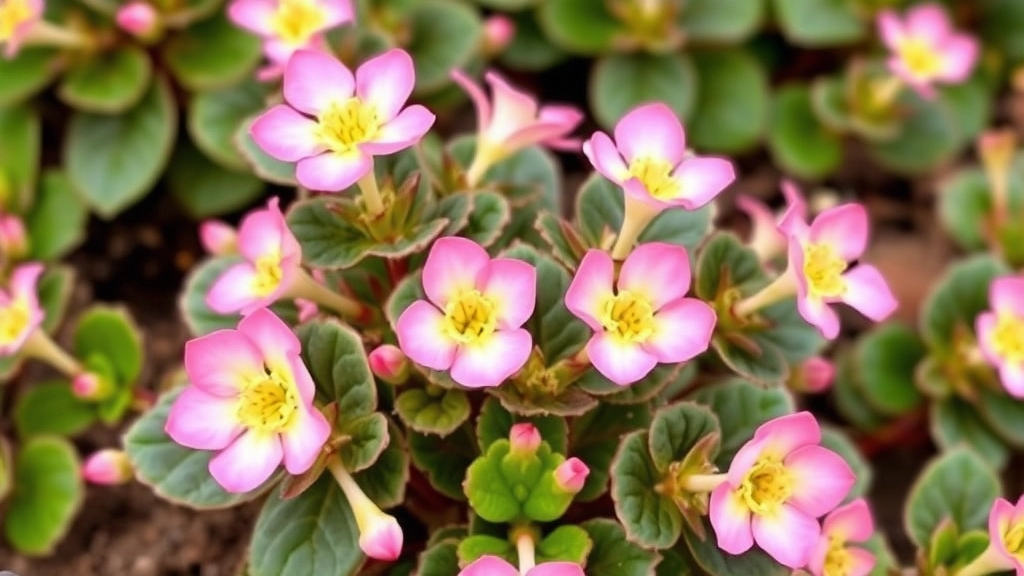
Alright, let’s chat about keeping your Kalanchoe Blossfeldiana happy all year round. Trust me, it’s not as tricky as it sounds!
Spring: Wakey-Wakey!
- Time to wake up your plant from its winter snooze
- Gradually increase watering and feeding
- Perfect time for repotting if needed
- Watch for new growth and give it a little trim if it’s looking leggy
Summer: Livin’ the Good Life
- Keep an eye on the soil – it might dry out faster in the heat
- Move to a shadier spot if the leaves start looking crispy
- Deadhead spent blooms to encourage more flowers
- Consider moving outdoors, but watch out for scorching sun!
Autumn: Prepping for the Chill
- Start cutting back on water and fertilizer
- Move plants indoors before the first frost
- Give it a good once-over for any pests hitching a ride inside
- Reduce light exposure to trigger blooming for winter
Winter: Showtime!
- This is when your Kalanchoe really shines
- Keep it in a bright spot, but away from cold drafts
- Water sparingly – overwatering in winter is a common oopsie
- Enjoy the blooms, but don’t stress if it’s not flowering – it’s normal
Here’s the thing: Kalanchoe Blossfeldiana is pretty chill (pun intended) when it comes to care. But paying attention to these seasonal shifts can make a world of difference.
Remember, it’s all about mimicking its natural habitat. In the wild, these succulents deal with dry seasons and wet seasons. We’re just recreating that cycle in our homes.
Got any specific seasonal issues with your Kalanchoe? Drop ’em in the comments, and let’s troubleshoot together. After all, plant care is a journey, not a destination!
Benefits of Kalanchoe Blossfeldiana
Let’s chat about why Kalanchoe Blossfeldiana is such a gem in the plant world.
Ever wondered why these little beauties are so popular?
Well, buckle up, because I’m about to spill the tea on all the perks of having this plant around.
Air Purification Champ
First off, these guys are like natural air filters.
They suck up nasty toxins from the air, making your space fresher.
Who doesn’t want cleaner air without lifting a finger?
Low Maintenance Superstar
Hate high-maintenance plants? Kalanchoe’s got your back.
These tough cookies can handle a bit of neglect.
Forget to water for a week? No biggie.
Perfect for busy bees or forgetful plant parents.
Mood Booster Extraordinaire
Feeling down? Kalanchoe’s vibrant blooms can perk you right up.
It’s like having a little burst of sunshine in your room.
Studies show plants can boost mood and productivity.
So, it’s not just pretty – it’s practically a therapist!
Space-Saving Wonder
Living in a shoebox apartment? No problem.
Kalanchoe doesn’t need much space to thrive.
Pop it on a windowsill or tiny desk corner.
Big impact, small footprint – that’s the Kalanchoe way.
Gift-Giving Gold
Stuck on what to get someone? Kalanchoe to the rescue!
It’s the gift that keeps on giving (literally, it keeps blooming).
Perfect for housewarming, birthdays, or just because.
Trust me, it beats another scented candle any day.
Long-Lasting Blooms
Sick of flowers that wilt in a week?
Kalanchoe flowers can last for months with proper care.
That’s more bang for your buck, and less time replacing dead plants.
Versatile Decor Piece
These plants are like the chameleons of the plant world.
They fit in anywhere – modern, rustic, minimalist, you name it.
Plus, they come in loads of colours to match your vibe.
Stress Reducer
Feeling frazzled? Spend a few minutes tending to your Kalanchoe.
Gardening, even on a small scale, can lower stress levels.
It’s like meditation, but with prettier results.
Easy Propagation
Want more plants without spending more cash?
Kalanchoe’s easy to propagate.
One plant can turn into many – it’s like free plants!
Share with friends or expand your own collection.
So there you have it – Kalanchoe Blossfeldiana isn’t just a pretty face.
It’s a multi-tasking marvel that brings a ton of benefits to the table.
Whether you’re a plant newbie or a green-thumbed pro, this little powerhouse has something for everyone.
Troubleshooting Common Issues
Alright, let’s dive into the nitty-gritty of Kalanchoe Blossfeldiana problems. Trust me, I’ve been there, scratching my head over why my plant’s looking a bit off. But don’t worry, we’ll sort it out together.
Yellowing Leaves: What’s the Deal?
Ever noticed your Kalanchoe’s leaves turning yellow? Yeah, it’s a pain. Here’s the scoop:
- Overwatering: The most common culprit. These succulents hate wet feet.
- Nutrient deficiency: Your plant might be crying out for some food.
- Too much sun: Believe it or not, even sun-lovers can get sunburnt.
Quick fix: Ease up on the watering, give it a feed, or move it to a slightly shadier spot.
Droopy Leaves: The Sad Plant Syndrome
If your Kalanchoe’s looking like it’s had a rough night out, it might be:
- Thirsty: Yep, sometimes they actually need more water.
- Cold: These guys aren’t fans of chilly drafts.
- Root rot: The dreaded consequence of overwatering.
Solution: Check the soil moisture, move it away from cold spots, and if you suspect root rot, it’s time for some plant surgery.
No Flowers: Where’s the Bloom?
So, your Kalanchoe’s all leaves and no action? Here’s what might be up:
- Not enough light: These guys need their beauty sleep (aka darkness) to bloom.
- Wrong season: They’re winter bloomers, so don’t expect flowers in summer.
- Overfertilizing: Too much of a good thing can backfire.
Try this: Give it 14 hours of darkness daily for a few weeks, be patient, and ease up on the fertilizer.
Pest Problems: Uninvited Guests
Spotted some creepy crawlies? Don’t panic. Common culprits include:
- Mealybugs: Look like little cotton balls.
- Spider mites: Tiny red spiders that leave webbing.
- Aphids: Small, usually green, and clustered on new growth.
Battle plan: Isolate the plant, wipe down leaves with soapy water, and consider neem oil for persistent pests.
Leggy Growth: The Stretchy Plant Syndrome
If your Kalanchoe’s looking like it’s reaching for the stars, it’s probably not getting enough light. Simple fix: Move it to a brighter spot, but introduce it gradually to avoid shock.
Remember, troubleshooting Kalanchoe Blossfeldiana issues isn’t rocket science. Most problems boil down to water, light, or pests. Keep an eye on your plant, adjust as needed, and you’ll be golden. And hey, if all else fails, there’s always propagation to start fresh!
Frequently Asked Questions about Kalanchoe Blossfeldiana
How often should I water my Kalanchoe Blossfeldiana?
Water your Kalanchoe when the top 2 inches of soil feel dry. This usually means watering once a week in summer and every 2-3 weeks in winter. Remember, it’s better to underwater than overwater these succulents.
Why isn’t my Kalanchoe blooming?
Kalanchoe Blossfeldiana needs a period of darkness to trigger blooming. Try giving it 14 hours of complete darkness daily for a few weeks. Also, ensure it’s getting enough bright, indirect light during the day.
Can I keep my Kalanchoe outdoors?
Yes, you can keep Kalanchoe outdoors in warm weather. However, bring it inside when temperatures drop below 50°F (10°C). When outdoors, protect it from direct, harsh sunlight to prevent leaf burn.
How do I propagate my Kalanchoe?
The easiest way to propagate Kalanchoe is through leaf or stem cuttings. Allow the cutting to callous over for a day or two, then plant it in well-draining soil. Keep the soil slightly moist until roots develop.
Is Kalanchoe Blossfeldiana toxic to pets?
Yes, Kalanchoe Blossfeldiana is toxic to cats and dogs if ingested. Keep it out of reach of pets, and seek veterinary care if you suspect your pet has eaten any part of the plant.
How long do Kalanchoe flowers last?
With proper care, Kalanchoe flowers can last for several weeks to a few months. Deadheading spent blooms can encourage more flowering.
Why are my Kalanchoe’s leaves turning yellow?
Yellowing leaves often indicate overwatering. Ensure your pot has good drainage and allow the soil to dry out between waterings. Yellowing can also be caused by nutrient deficiency or too much direct sunlight.
How often should I fertilize my Kalanchoe?
Fertilize your Kalanchoe every 2-4 weeks during the growing season (spring and summer) with a balanced, water-soluble fertilizer diluted to half strength. Reduce or stop fertilizing in fall and winter.
Can I prune my Kalanchoe Blossfeldiana?
Yes, pruning can help maintain shape and encourage bushier growth. Prune after flowering, cutting back stems to just above a leaf node. Always use clean, sharp scissors to avoid damaging the plant.
How do I get my Kalanchoe to rebloom?
To encourage reblooming, provide a period of darkness (14 hours per day) for about six weeks. Reduce watering and stop fertilizing during this time. Once buds appear, resume normal care.
References
-
Missouri Botanical Garden – Kalanchoe blossfeldiana Kalanchoe blossfeldiana
-
University of Wisconsin-Madison Extension – Kalanchoe Kalanchoe
-
Royal Horticultural Society – Kalanchoe blossfeldiana Kalanchoe blossfeldiana

